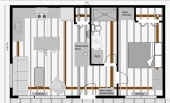Hello again,
I have finally ironed out a stove design i would love some feedback on if anyone with experience has time. This is a 6.3" Sidewinder batch box with an oven above the heat riser. I have done my best to follow all Peter's specifications from batchrocket.eu. If you see dimensions that are not right, please let me know. I do have a few questions below as well.
Core:
On Peter's site the image of the
Sidewinder Brick Core shows angled bricks in the fire box. I could not find any measurements for these. Does anyone know what they should be for a 6.3" sidewinder?
Oven:
The oven floor in this design will be flush, or slightly below the top of the heat riser. It is similar to
this stove on Peter's site. I am assuming the arch will have to be fire brick because its above the heat riser. Is there anywhere else (besides the core itself) that should be firebrick?
Chimney:
I drew this design with the flue pipe encased in bricks. One of the walls of the chimney is the support for a portion of the arch. What are the pros and cons of this design if any? If i let this brick function as the chimney (with out flue pipe up until the top of the bell, would the chimney then have to be included in the ISA? Also, how much of a gap should there be between the bottom of the chimney and the floor of the bell?
ISA:
I have calculated the ISA at 62.5sqft. This is higher than the target number for a 6" (57sqft), and below that of a 7" (77sqft). I'm hoping this is about right, but let me know if it is too big. I could not find a number for a 6.3" system. My calculation includes the side walls, inside of arch, and both the top and bottom surface of the oven floor. It does not include any part of the core. Should the core be included in the ISA of this design?
I think thats my questions for now. I am also going to do a similar design with the shorty sidewinder core, just to see if I like that better. We will see.
Thanks again for any input you have!
-Eloise








